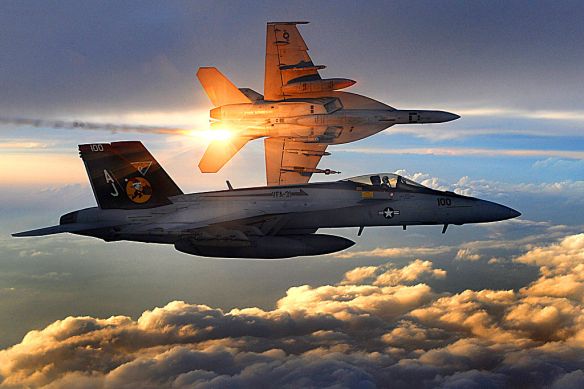Two U.S. Navy F/A-18 Super Hornets of Strike Fighter Squadron 31 fly a combat patrol over Afghanistan, Dec. 15, 2008.
The Navy had originally hoped to replace the F/A-18 with a navalized version of the USAF’s advanced tactical fighter (ATF), but as events turned out, the winning entry, the Lockheed YF-22, proved to be too costly to supply the numbers of aircraft that would be needed after the year 2000. Because of the risks associated with ATF, the Navy simultaneously investigated the feasibility of procuring an improved derivative of the F/A-18 under a plan known as Hornet 2000, which eventually led, in early 1992, to a contract for the development of the F/A-18E (single-seat) and F (two-seat) Super Hornet. Though sharing 90 percent of the F/A- 18C/D’s avionics and software, the F/A-18E/F has been redesigned to include state-of-the-art cockpit displays, a 34-inch fuselage extension, two additional multi-mission weapons stations, a 25 percent increase in wing area, a 35 percent increase in engine power (General Electric F414-GE-400 engines with 22,000-lbs./s. t. each), and a 33 percent increase in internal fuel capacity. At a slight cost in top speed (Mach 1.6), the Super Hornet possesses a 40 percent improvement in combat range (800 miles) and can carry a 30 percent greater external load (17,750-lbs.) The first F/A-18E flew in November 1995, delivery of production models began in late 1998, and the type entered operational service in late 1999. Under current contracts, the Navy intends to buy a minimum of 548 Super Hornets through 2010, with tentative plans to keep the type in production until 2014.
In 2002 Boeing received the go-ahead to develop the EA-18G Growler, a two-seat electronic countermeasures version of the F/A-18F that will over time replace the Grumman EA- 6B Prowler. Because of advances in computerization, the EF-18G will not only undertake the electronic warfare mission of the four-seat EA-6B, but will also keep much of the F/A-18F’s offensive capability. Production of least 90 EA-18Gs is planned according to current estimates.
VFA-115 became the first Navy squadron to be declared combat-ready with F/A-18E Super Hornets in June 2001, and the type is equipping four more active squadrons as of mid-2004. After September 11, 2001, Super Hornets of VFA-115 flew missions off Afghanistan in support of Operation Enduring Freedom and more recently, saw action in Operation Iraqi Freedom, where they flew air defense sorties and expended more than 380,000-lbs. of munitions.
